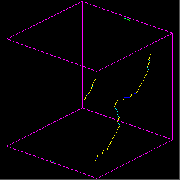I performed my PhD thesis in materials physics, supervised by Dr. Sandrine Brochard, Dr. Laurent Pizzagalli, and Dr. Pierre Beauchamp, in the Phymat laboratory, today part of the Pprime Institute, at the University of Poitiers, France. The title of this thesis is:
Study by atomic-scale simulations of the formation of dislocation loops
from surface ledges in a metal under stress
The full manuscript of this thesis is available (in French) from the Uni. Poitiers web site, from Thèse En Ligne, or directly from here. A list of our publications and communications on this subject is available from this page. Below, a brief review of this work is given.
In bulk materials, plastic (i.e. irreversible) deformation is strongly linked to the multiplication of dislocations from preexisting sources, such as Frank-Read sources (Fig.1). At the nanometric scale, dimensions become too small for such mechanisms to occur. Plasticity is then initiated by different mechanisms, especially the formation of new dislocations from surface and interface defects. The understanding of these elementary mechanisms is essential, since nanostructured materials are used in numerous fields where size reduction makes every defect a major perturbation for electronic, optical, and mechanical properties.

Fig. 1 - A Frank-Read source allows the multiplication of dislocations (Credits: B. Devincre/ONERA).
We have studied these mechanisms of deformation in aluminium, using atomic-scale simulations. Molecular dynamics (MD) using semi-empirical potentials is well suited to such a study, because it allows the modelling of several hundreds of thousands of atoms, getting simulations closer to real systems. Our study focuses on the formation of dislocations from surface ledges such as steps, in a slab of aluminium under stress.
The formation of a dislocation from a surface step puts two sets of forces in competition. On one hand, the applied stress favors the formation and propagation of dislocations, which releases stress in the material. But on the other hand, the dislocation is attracted to the surface because of the so-called image force, which prevents it from propagating. The dislocation line tension, and the presence of a stacking fault of high energy, make even more difficult the formation of the dislocation in our case. Because of the competition between these forces, it exists an equilibrium position for the dislocation, where all forces acting on it annihilate; we call this position the critical radius of the dislocation. At this position, the system energy is maximum. The formation of the dislocation depends on the crossing of this energy barrier, which is possible only through thermal activation. We aimed at determining these parameters (activation energy and critical radius) with several methods.
Fig. 2 - A simulation at 300 K, showing a dislocation half-loop forming from a surface step. Only atoms that are not in a perfect fcc environment are represented (i.e. atoms in surfaces and defects).
Download the video (OGG/Theora format, open with VLC).
The video above shows the mechanism observed in finite-temperature molecular dynamics simulations. Because of the thermal motion, dislocation embryos form from the surface steps; however they are attracted back to the surface if their radius is too small. When a dislocation reaches the critical radius, then it crosses the energy barrier and propagates. The crossing of this barrier by the dislocation is thus a sine qua non condition for the plastic deformation of the material. After this first event, other dislocations form, leading to the formation of a twin.
At first, the continuum theory of dislocation, known since the 1950s, can seem a good way to handle this problem. We built a custom model, which provides analytical equations for the critical radius and the activation energy. However, it has several intrinsic limitations, so we turned to atomistic simulations, by modeling the interactions between atoms with EAM potentials. Molecular dynamics (MD) allows the drawing of Arrhenius plots, which relates temperature and reaction rate to obtain the activation energy. However this method revealed a poor efficiency, because of the very long simulation times and the great number of simulations required to make it reliable. Hence other methods had to be employed.
To determine activation parameters, we used static methods. A trial-and-error method allows a quick determination of the critical radius. A constrained relaxation method gives the activation energy, though not very precisely. And the NEB method grants access to the full minimum energy path of the nucleation event, and thus to the activation parameters. The combined use of these atomistic methods, and the custom elastic model, allows a reliable determination of the variation of the activation energy with the applied strain, as shown below.
Fig. 3 - Activation energy versus applied strain, computed by different methods.
In this thesis, we also studied the influence of several external factors (temperature, surface condition...) on the nucleation stress. Several surface defects were investigated. Simulations on aluminium films containing multilayer steps have shown that an increase in the initial step height does not make nucleation easier; local effects probably occur for small step heights. The presence of kinks along the steps do not ease nucleation either, as the stress is lowered on this kind of sites. Dislocations do not form from the kinks, and the nucleation stress does not decrease when kinks are present along a step.
Finally, informations on the dynamics of the dislocations were obtained. We have shown that the dislocations propagate at near the speed of sound waves in the material, and that the core extension decreases as the dislocation velocity increases. All these results are in agreement with the theory of elasticity, and with previous experimental and theoretical studies. In some simulations, we observed the activation of Frank kinetic sources, a particular source for the formation of dislocations.
[1] P. Hirel et al., Scripta Mater. 57 (2007) 1141-1144. doi: 10.1016/j.scriptamat.2007.08.016
[2] P. Hirel et al., Phys. Rev. B 78 (2008) 064109. doi: 10.1103/PhysRevB.78.064109
[3] S. Brochard et al., Acta Mater. 58 (2010) 4182-4190. doi: 10.1016/j.actamat.2010.04.009
Copyright © Pierre Hirel 2009-2024